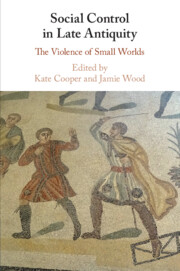Book contents
- Social Control in Late Antiquity
- Social Control in Late Antiquity
- Copyright page
- Contents
- Contributors
- Preface and Acknowledgements
- Abbreviations
- Introduction
- Part I Women and Children First
- Part II ‘Slaves, be subject to your masters’
- Part III Knowledge, Power, and Symbolic Violence
- Part IV Vulnerability and Power
- Chapter 13 Reading Thecla in Fourth-Century Pontus
- Chapter 14 Family Heroines
- Chapter 15 Women on the Edge
- Bibliography
- Index
Chapter 15 - Women on the Edge
Violence, ‘Othering’, and the Limits of Imperial Power in Euphemia and the Goth
from Part IV - Vulnerability and Power
Published online by Cambridge University Press: 18 September 2020
- Social Control in Late Antiquity
- Social Control in Late Antiquity
- Copyright page
- Contents
- Contributors
- Preface and Acknowledgements
- Abbreviations
- Introduction
- Part I Women and Children First
- Part II ‘Slaves, be subject to your masters’
- Part III Knowledge, Power, and Symbolic Violence
- Part IV Vulnerability and Power
- Chapter 13 Reading Thecla in Fourth-Century Pontus
- Chapter 14 Family Heroines
- Chapter 15 Women on the Edge
- Bibliography
- Index
Summary
This chapter analyses the little-known fifth-century Syriac romance Euphemia and the Goth, bringing out its narrative richness to allow it to become part of a wider discourse about identity, violence, and the role of women in the late antique eastern Empire. By employing a structuralist methodology, the story is viewed as containing highly developed and also subtle contrasts, ultimately used by the author to articulate a view of an ideal Edessa. Through the use of distance, dichotomies of barbarian and civilised are set and reinforced with the complimentary distinctions of legitimate and illegitimate violence. These contrasts also allow the primary benefit of Roman rule for Edessa to be made clear, namely the rule of law which ensures justice for vulnerable female-only households against outsiders who attempt to disrupt them, albeit with a strong Edessan identity retained. The analysis finishes by shedding light on the position of women within Edessa at the turn of the fifth century and concludes that options for female-only living were perhaps more positive than for women elsewhere in the Empire.
Keywords
- Type
- Chapter
- Information
- Social Control in Late AntiquityThe Violence of Small Worlds, pp. 318 - 336Publisher: Cambridge University PressPrint publication year: 2020



